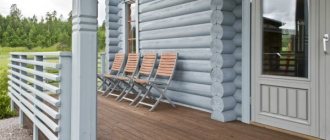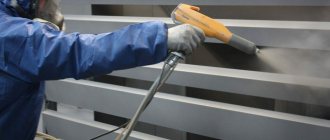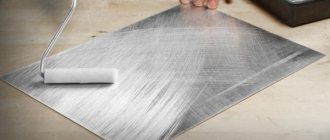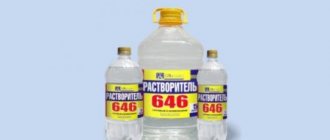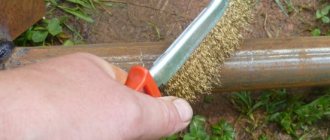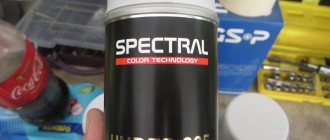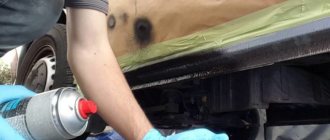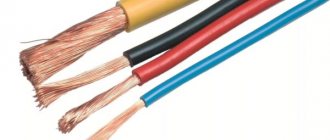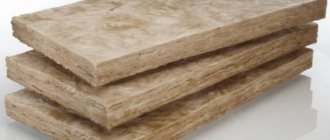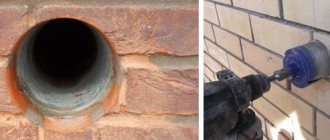Painting is a popular way to change the color of metal. To obtain the desired result, it is important to strictly follow the technology and select the paint, taking into account the operating conditions of the enamel. Painting metal allows you to change the design of the surface, protect the material from the destructive effects of moisture and the formation of rust.
Painting metal surfaces
The essence and features of the method
Painting of metal products was initially used to change color and give surfaces an interesting shade, but simple enamel quickly cracked and rust appeared underneath. Therefore, manufacturers began to develop new types of coloring compounds that could protect the metal from corrosion.
On sale you can find different types of paint that is suitable for metal surfaces. It can be applied in different ways. In this case, hand tools and industrial equipment are used.
Selection of paint and methods of painting metal structures
When choosing paint and primer, it is important to familiarize yourself with the features of two-component and multi-component compositions - some require a special technological process.
It is recommended to count the number of packages or cans of paint in advance. There are special programs or online calculators for this - very convenient when there is a large volume of surface to be painted.
In addition to traditional dyes, there are specialized compounds that are highly toxic. The job requires a sufficient level of professionalism.
To increase the reliability of the anti-corrosion coating and the durability of metal structures, special materials are required:
- Liquids or special viscous masses to prevent corrosion to which frames, supports and metal trusses are exposed in the open air;
- Compositions effective for painting surfaces affected by rust formation. They contain additives that neutralize this process and provide protection from the cured epoxy resin. Painting of metal structures is carried out on rusty fragments of structures;
- Primer-enamel. A universal composition that combines the unique properties of different types of coatings;
- Forging compounds (polymer based) are suitable for forged products. They contain fine-grained (ground) glass and aluminum powder and have increased wear resistance;
- Hammer compounds provide an impressive coating that resembles the surface after small impacts. They are produced on the basis of traditional enamels (alkyd, cellulose nitrate, epoxy) with the addition of aluminum powder and polymers, which gives a semblance of “tightening”; pigment is added to it;
- Nitro paint is less in demand due to toxicity; it is used mainly for outdoor work. A simple technology for painting metal structures, but it is more convenient to work with a spray can or spray gun.
Along with paints and enamels, varnishes for metal products are produced. The most in demand are heat-resistant ones - “oven”, polyurethane and alkyd varnish. Black bitumen is used much less frequently than acrylic varnish (a harmless interior composition).
Hammer compounds provide an impressive coating that resembles the surface after small impacts.
Is it possible to paint metal?
Metal structures are often made of black iron. Since this material oxidizes very quickly, it must be protected from moisture and rust. For this purpose, special anti-corrosion compounds or metal paint can be used.
Galvanized metals, thanks to a layer of zinc and chromium, are already protected from rust. The protective layer retains its integrity for up to 15 years. If you want to increase this figure, the surfaces can be additionally painted.
Painted disc
Padding
The next step is to apply the primer material. It helps to avoid the influence of an aggressive environment and protects against rust. In addition, this particular layer will help create maximum adhesion to the paint.
To work with ferrous metals, select materials with anti-corrosion coating. You can apply it in any way (using a brush, roller, spray).
Application methods
To apply paint you can use:
- Paint brush. Suitable for painting small parts. You can find brushes of different sizes on sale. The bristles can be natural or synthetic. For access to hard-to-reach places, the tool is equipped with an elongated curved handle.
- Roller. Suitable for painting large flat surfaces.
- Sprayers. The second name for the spray gun. A compressor is used to operate them. The coloring composition is supplied under pressure. The equipment is used by large enterprises, car repair shops, carpentry, and blacksmith shops.
- Containers for dipping metal workpieces. This method makes it easy to paint parts with complex shapes.
Modern technology - powder coating of metal. The blanks are placed in a closed spray booth and covered with a layer of paint. Its particles receive a negative electrical charge and are attracted to the working surface, creating a dense, uniform layer. After applying the powder, the workpiece is placed in an oven so that the decorative layer bakes and becomes monolithic.
Paint brush
Painting technology
To apply paint to a metal surface, use a roller, brush, or spray gun. The algorithm of actions directly depends on the tool. Use a roller to paint large, even surfaces. The brush is chosen for complex or relief areas. The spray gun is relevant for large metal surface areas.
When using a roller:
- the paint is diluted with a solvent, achieving a consistency that facilitates easy distribution over the surface, and poured into a tray;
- the instrument is immersed in paint, ensuring sufficient wetting;
- roll the roller over the surface, making back-and-forth movements;
- form 2 – 4 layers.
Important! Application of the next layer begins after the previous one has dried.
When painting with a brush, the tool is immersed in paint to 1/3 of the length of the bristles. The composition is applied to the surface, making movements in one direction. First, a certain amount of paint is applied to the base and then rubbed onto the metal surface.
When using a spray gun, it is possible to maximize painting productivity. Due to the low absorbency of the metal surface, increased demands are placed on the operator’s qualifications in terms of smoothness and speed of movements. The layers are applied in parallel.
Surface cleaning
In order to create a high-quality enamel or paint coating, metal surfaces must be prepared. Preparing metal for painting is a multi-part process.
Painting and preparation are preceded by necessary repairs that cannot be carried out after the coating is created - this includes leveling surfaces, eliminating minor damage, welding, and so on.
The actual preparation process begins with cleaning and degreasing the surface. Any plaque and dust will prevent paint adhesion and the formation of an even enamel film. Therefore, hydrodynamic or sandblasting devices are used to remove all contaminants.
It is especially important to remove old paint and primer from the metal surface, if any, because if this is not done, then the quality of adhesion of the new paint will not be higher than that of the old one - in other words, they will peel off and fall off together. In addition, old paint can enter into a chemical reaction with new paint and deteriorate its properties.
After cleaning, it is necessary to level the surface and remove rust from it, because even sandblasting does not completely clean the metal. Using steel brushes, both manual and mechanical, workers remove all traces of corrosion and uneven metal. If the work is carried out at height, then people will be required whose professional skills include industrial mountaineering. Working with steel brushes can be the longest of the preparation steps.
To remove rust, chemical compounds that replace abrasive materials can also be used. Even if the paint and varnish materials used have rust-reducing properties, the existing effects of corrosion must be eliminated as much as possible - the paint will not stick to the metal covered with powder rust.
Surface primer
Then the surface is primed. The primer improves the protective properties of the finishing paint, extends its service life, and at the same time reduces its consumption. The primer should also prevent rust from forming again. A coating consisting of a layer of primer and a layer of finishing paint is more resistant to both atmospheric and mechanical damage.
Technologies for applying paints and enamels
Painting, that is, applying a finishing coat of paint (one or several), can be carried out in one of several ways, depending on the specifics of the object, its operating conditions and the circumstances of the work.
Hand painting
The simplest and most traditional option is hand painting with rollers and brushes. This method allows high-quality painting of any complex surface, but is not always applicable to quick-drying materials, and it also takes longer than other methods. Painting with a brush does not allow you to achieve a completely flat surface, but it does provide high adhesion of the material.
The manual painting method is most often used when not the entire surface of the object needs to be painted. In this case, protective coatings are applied to the unpainted parts to prevent paint adhesion, or stencils are applied.
High pressure dyeing
You can use a high-pressure apparatus to paint metals using the airless method. This method is characterized by high speed and productivity, in addition, when working with an airless spray gun, there is no fog at all. Airless painting is possible both in one layer and in several layers, as well as with preliminary priming using the same method. The main areas of application for airless painting are construction and industrial sites with large flat areas.
It is generally accepted that with airless spraying, unlike pneumatic spraying, the droplet size is significantly non-uniform, so the film is not perfectly uniform. However, painting using a material of the required viscosity gives a smooth, streak-free surface that does not require sanding or trimming.
For painting surfaces with complex configurations, as well as small parts, this painting technology is ineffective and uneconomical. When painting large areas, as well as when painting for the purpose of protection against corrosion (using special compounds), this method is indispensable. Its other advantages include low consumption of paint and thinners.
Powder coating
Finally, metals can be powder coated in a factory. This method requires special technological conditions and non-portable equipment, so it is not applicable for painting objects in the field. At the same time, when painting, for example, pipeline pipes in industrial conditions, it is the most effective and efficient.
Powder painting is done on a special line. A grounded object is placed in an electrostatic field, into which paint particles are then introduced, which receive an electrical charge and adhere to the object being painted in an even layer. After this, it is sent to a special oven, where the paint is heated and baked into a durable, even coating. In this way it is possible, for example, to uniformly paint pipes not only from the outside, but also from the inside.
Types of coloring compositions
Varieties:
- Oily. Suitable for decorative finishing of surfaces indoors and outdoors. Made from organic substances. Before applying oil paint, you need to cover the working surface with primer. The main disadvantage is the persistent pungent odor. Such enamels can only be used in ventilated areas.
- Epoxy. Manufactured on the basis of silicone resin. In order for the composition to set, different hardeners are used. Can only be used for exterior painting as they are highly toxic. It is difficult to work with epoxy paints, but the finished coating reliably protects surfaces from rust.
- Acrylic. The basis of such paints are polymers. Suitable for painting metal parts indoors.
- Alkyd. Used for external and internal work. Easy to apply, no primer required.
- Rubber. Special dyes used to coat the external sides of building walls and roofs. Withstands prolonged exposure to moisture and ultraviolet radiation.
For metal, you need to choose paints that protect against rust. Before painting, the surfaces must be coated with a primer containing a high zinc content.
How to calculate paint consumption?
The paint consumption for metal can be found on the container. It is indicated on the back of the label or front side. If for some reason there is no designation, you need to know that 1 liter is enough for about 14 m2.
Consumption depends on the application method, the presence of complex elements, surface structure, and type of paint.
Types of processing of rusty metal surfaces
The choice of rust treatment method depends on the degree of corrosion and the type of item itself. It is also necessary to consider what metal care products are available and available for use.
The most common processing methods include:
- Chemical.
- Mechanical.
- Thermal. It is carried out using a torch.
Rust cannot be removed by washing with plain water. For this purpose, targeted, comprehensive processing is required.
You will find all the most useful and important information about rust removal methods and techniques in this section.
Thermal
The thermal method is rarely used . The use of an oxygen-acetylene torch makes it possible to remove mill scale well, but does not completely remove rust.
Burners must be used under suitable conditions. Despite the high traumatic nature of the method, its effectiveness is inferior to chemical treatment.
Mechanical
Physical impact on rust is designed to remove the top layer of material that has become loose. This can be done in several ways:
- manually (using a brush with metal bristles and scrapers);
- using a grinding machine or a special machine.
In addition to those products that are available at home, industrial enterprises also use serious devices using special equipment to treat rust:
- shot blasting;
- water sandblasting;
- sandblasting
The best result is obtained by a combination of abrasive and chemical effects.
Chemical
Chemical treatment is carried out using homemade products and purchased, ready-to-use preparations. In addition, large metal surfaces are also subjected to special influences that help preserve and protect the material:
- connection with organic additives, providing bluing;
- cementation - a chemical reaction with carbon;
- nitriding, etc.
The chemical method allows you to remove rust through a chemical reaction using substances that are active against corrosion products.
Treatments carried out at home include:
- preparation of material;
- exposure to a chemical;
- wash.
The type of chemical exposure must take into account the degree of damage to the metal.
Advantages and disadvantages of the method
The pros and cons of painting metal depend on the type of paint composition used. Advantages of painting metal surfaces, provided the technology is followed:
- Getting the required shade. You can find different colors on sale.
- Availability of consumables.
- Easy to apply paint using a brush or roller.
- Protection against rust formation.
Flaws:
- Many types of coloring compounds emit a persistent, unpleasant odor. The room needs to be ventilated for a long time.
- For powder coating you will need special equipment, a spray booth.
- Not all types of paint protect metal from corrosion.
Most of the shortcomings can be leveled out if you buy a high-quality coloring composition and carry out the work strictly following the technology.
Advantages of contacting
The key advantage of cooperation with our company remains reasonable prices per m2 of painting metal structures at height. We are engaged in servicing objects for various purposes, offering our clients competitive prices for the entire range of services. The cost of painting metal structures is announced by a company employee during the initial inspection and subsequently does not change.
Our specialists will readily begin to fulfill the order, starting their work immediately after placing it. Contact our manager in the most convenient way for you and discuss all the details of cooperation with the company. Inspection, calculation and signing of the contract will be carried out upon leaving the site.
Coloring at home
If necessary, metal products can be painted yourself. To do this, you need to choose a method for applying enamel, prepare the required tools and surfaces, and apply the composition.
Tools and equipment
For the classic method of painting metal, you need to prepare:
- roller, brushes of different widths;
- paint container;
- the coloring composition must be shaded;
- primer for metal.
Additionally, you will need masking tape and plastic film.
Surface preparation
Do not apply paint to unprepared surfaces. Before starting work, you need to perform several steps:
- Clean the metal from dirt and rust. To do this, you can use a grinder, grinder, metal brush or acid.
- Degrease surfaces with solvent.
- Putty the uneven areas.
After the preparatory work, you can apply a primer.
Preparation of material
Application of the composition
Surfaces that do not need to be painted should be covered with plastic film. The edges must be covered with masking tape. Painting with a brush is easy. It needs to be dipped 1/3 of the way. The number of layers depends on the desired result.
Do-it-yourself painting of metal products - surface preparation
The result you get also depends on how correctly you prepared the surface of the product. First of all, it is necessary to clean the structure of any debris, deposits, old layers of paint and varnish. Scrapers are usually used for work, but you can use sandpaper or a metal sponge.
Stains of salt, oil and fat - everything must be washed off. It's best to use non-abrasive cleaners, even a soap and water solution. After this, be sure to rinse the surface with clean water and let it dry.
If you have to work with a very large product, you can use an acid-acetylene torch. As a result, the paint will burn and the rust layer will fall off.
If you cannot remove the rust, you can use a converter. This is a mixture prepared on the basis of phosphoric acid. The affected part of the structure is covered with the mixture and left for more than 3 hours. After this, you need to rinse everything off with water and dry it.
Recommendations and safety precautions
Safety regulations:
- The room in which the work will take place must be well ventilated.
- If the solvent is spilled, the resulting stain must be covered with sand.
- You should work in a respirator, safety glasses, gloves, and long-sleeved overalls.
- The remaining paint must be poured into a separate container and sealed tightly.
- Used jars should be washed or thrown away.
Do not pour any remaining paint down the drain.
Metal painting is performed to change the shade of the product and protect the material from rust. To obtain the desired result, you need to choose one of the possible methods of applying the coloring composition and select the paint. Attention should also be paid to the preparation of metal surfaces. Without it, the decorative coating will be destroyed in a short period of time.
Preparing metal structures for painting
Before you start painting a metal surface, perform the following steps:
- The metal is cleaned of oxides and scales using jet-abrasive, hydraulic methods or steel brushes. Remove fat and oil stains using organic solvents and alkaline solutions. Upon external inspection, there should be no traces of rust, welding spatter, flux residues, burrs, markings or other corrosion products on the surface.
- Degrease the surface with water detergents. White spirit with an optimal oil content of no more than 5 g/l has effective dissolving ability. Highly toxic liquids such as toluene, gasoline, solvent, dichloroethane, carbon tetrachloride are not suitable for processing.
- Dust removal is carried out by blowing the product with compressed air or wiping it with a soft wide brush.
- Restore layers of primer previously applied by the manufacturer that were damaged during transportation or as a result of mechanical stress.
If there is a need for additional cleaning from loose rust and excess deposits, rust modifiers are used, for example, phosphoric acid etched with zinc powder.
Modifiers are applied by double shading in the form of vertical and horizontal strokes or by spraying. The surface treated in this way is left to dry completely for 10 hours at air temperatures from 15 to 200C and humidity not higher than 80%. Then they begin to prime the metal without washing off the remaining acid reagent.
The metal sheet or product prepared for painting must be dry, without oil deposits or areas of secondary corrosion that can form during the technological cleaning process. It is important to take into account the fact that cleaned and degreased steel in the open air soon begins to react with oxygen and becomes covered with a layer of hydroxide.
For factory conditions, conventional sandblasting devices are ineffective for cleaning. Here it is more advisable to use shot blasting or shot blasting, in which the metal is subjected to special effects.
The technologies differ from each other in the way the shot is supplied to the surface of the structure being processed. Shot blasting is characterized by powerful pneumatic ejection of abrasive particles from a turbine by streams of compressed air at high pressure. The shot blasting machine contains special shot throwers that clean the metal from all sides.
The advantages of using shot blasting equipment include:
- low power consumption;
- environmental friendliness;
- the process is fully automated and occurs without human intervention;
- high quality of output products;
- Maintenance and management of the installation is not difficult.
The use of shot blasting equipment helps to get rid of minor defects and contaminants and give the surface the required degree of roughness. During this treatment, the adhesion of the metal increases and the quality of the lacquer coating is improved. However, the described technology does not provide for cleaning the blocks and the internal cavity of the parts.
Shot blasters are much more expensive than shot blasting devices. Shot blasting involves preparing a metal surface before applying decorative paints and varnishes to give it strength and remove scale, oxides and corrosion stains.
This technology has its advantages:
- allows you to clean large metal structures and hard-to-reach areas;
- the cost of purchasing shot blasting equipment is lower;
- The abrasive material can be used repeatedly, so the technology is considered more practical and economical.
Despite the positive aspects, shot blasting chambers are inferior in productivity to shot blasting chambers, since the cleaning operations in them are only partially automated and require operator intervention.
